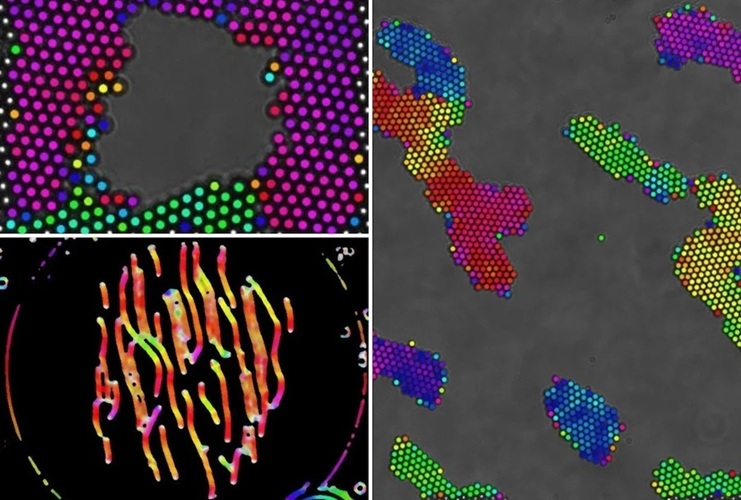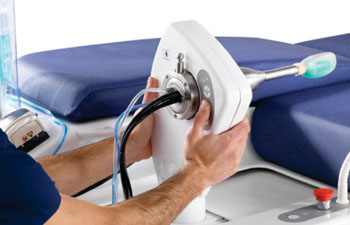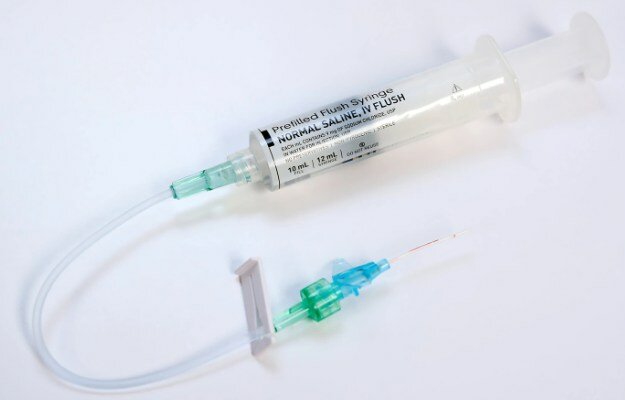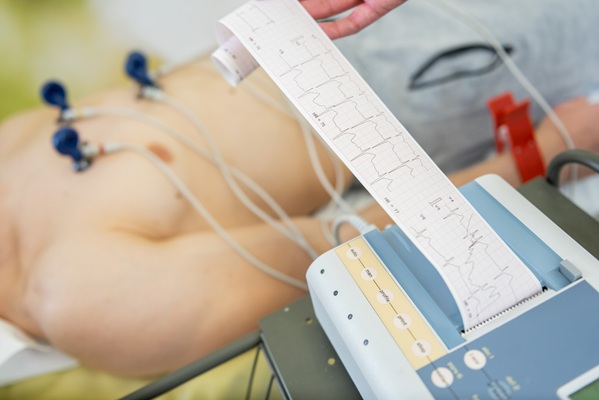Therapeutic Ultrasound System Ablates Prostate Tissue
|
By HospiMedica International staff writers Posted on 22 Nov 2015 |
A new high-intensity focused ultrasound (HIFU) system offers an effective option for prostatic tissue ablation with a low occurrence of side effects.
The Ablatherm HIFU system is intended for treating patients with localized prostate cancer (stages T1-T2) who are not surgical candidates due to age or comorbidities, those who prefer an alternative option, or for patients who failed previous radiotherapy (RT) treatment. The system itself consists of a treatment module, a control module, and a probe with both treatment and imaging transducers. After a spinal epidural or general anesthetic (GA) is administered, the patient lies down on his right lateral decubitus and stays in this position throughout the treatment.
The Ablatherm HIFU probe is then introduced in the rectum, and the imaging transducer scans the prostate gland to plan robotic treatment. Once the ablation sequence is finalized, the treatment transducer emits HIFU ultrasound in the prostate gland; at the focal point—where the ultrasound waves are focused—the absorption of the ultrasound emission beam creates a sudden temperature increase, to around 85 °C, which destroys the tissue in the targeted zone. The Ablatherm HIFU system is a product of EDAP TMS (Vaulx-en-Velin, France), and has been approved by the US Food and Drug Administration (FDA).
“This clearance represents a unique opportunity for EDAP and its superior HIFU technology to penetrate the largest prostate market in the world in the same way it has emerged as the leading HIFU technology in Europe,” said Marc Oczachowski, CEO of EDAP TMS. “The pieces are in place to begin deploying Ablatherm devices in the US very quickly, and we look forward to bringing the technology to urologists as well as patients in need.”
HIFU technology is based on nonlinear acoustic mathematical optimization methods to analyze and simulate the propagation of sound in material. The information is then used to enhance the shape of an acoustic lens in such a way that that ultrasound pressure is focused precisely on the location of the tissue to be ablated, while the surrounding tissue retains as little damage as possible.
Related Links:
EDAP TMS
Link to video
The Ablatherm HIFU system is intended for treating patients with localized prostate cancer (stages T1-T2) who are not surgical candidates due to age or comorbidities, those who prefer an alternative option, or for patients who failed previous radiotherapy (RT) treatment. The system itself consists of a treatment module, a control module, and a probe with both treatment and imaging transducers. After a spinal epidural or general anesthetic (GA) is administered, the patient lies down on his right lateral decubitus and stays in this position throughout the treatment.
The Ablatherm HIFU probe is then introduced in the rectum, and the imaging transducer scans the prostate gland to plan robotic treatment. Once the ablation sequence is finalized, the treatment transducer emits HIFU ultrasound in the prostate gland; at the focal point—where the ultrasound waves are focused—the absorption of the ultrasound emission beam creates a sudden temperature increase, to around 85 °C, which destroys the tissue in the targeted zone. The Ablatherm HIFU system is a product of EDAP TMS (Vaulx-en-Velin, France), and has been approved by the US Food and Drug Administration (FDA).
“This clearance represents a unique opportunity for EDAP and its superior HIFU technology to penetrate the largest prostate market in the world in the same way it has emerged as the leading HIFU technology in Europe,” said Marc Oczachowski, CEO of EDAP TMS. “The pieces are in place to begin deploying Ablatherm devices in the US very quickly, and we look forward to bringing the technology to urologists as well as patients in need.”
HIFU technology is based on nonlinear acoustic mathematical optimization methods to analyze and simulate the propagation of sound in material. The information is then used to enhance the shape of an acoustic lens in such a way that that ultrasound pressure is focused precisely on the location of the tissue to be ablated, while the surrounding tissue retains as little damage as possible.
Related Links:
EDAP TMS
Link to video
Read the full article by registering today, it's FREE! 

Register now for FREE to HospiMedica.com and get access to news and events that shape the world of Hospital Medicine. 
- Free digital version edition of HospiMedica International sent by email on regular basis
- Free print version of HospiMedica International magazine (available only outside USA and Canada).
- Free and unlimited access to back issues of HospiMedica International in digital format
- Free HospiMedica International Newsletter sent every week containing the latest news
- Free breaking news sent via email
- Free access to Events Calendar
- Free access to LinkXpress new product services
- REGISTRATION IS FREE AND EASY!
Sign in: Registered website members
Sign in: Registered magazine subscribers
Latest Surgical Techniques News
- Magic Silicone Liquid Powered Robots Perform MIS in Narrow Cavities
- 'Lab-on-a-Scalpel' Provides Real-Time Surgical Insights for POC Diagnostics in OR
- Biodegradable Brain Implant Prevents Glioblastoma Recurrence
- Tiny 3D Printer Reconstructs Tissues During Vocal Cord Surgery
- Minimally Invasive Procedure for Aortic Valve Disease Has Similar Outcomes as Surgery
- Safer Hip Implant Design Prevents Early Femoral Fractures
- New Nanomaterial Improves Laser Lithotripsy for Removing Kidney Stones
- Ultraflexible Neurovascular Microcatheter Delivers Therapies to Tiniest Blood Vessels

- Magnetic Soft Robotic Valve Provides Minimally Invasive Intervention for Acid Reflux
- Wireless Metamaterial Spinal Implants Can Feel, Heal and Communicate
- Major Study Examines Endoscopies that Fail to Detect Esophageal Cancer
- Robotic Assistant Delivers Ultra-Precision Injections with Rapid Setup Times
- Minimally Invasive Endoscopic Surgery Improves Severe Stroke Outcomes
- Novel Glue Prevents Complications After Breast Cancer Surgery
- Breakthrough Brain Implant Enables Safer and More Precise Drug Delivery
- Bioadhesive Sponge Stops Uncontrolled Internal Bleeding During Surgery
Channels
Critical Care
view channel
Breakthrough Ultrasound Technology Measures Blood Viscosity in Real Time
Blood pressure, pulse, temperature, and oxygen levels have long defined the core metrics physicians use to assess health — yet one key indicator has remained out of reach: blood viscosity.... Read more
Magnetically Activated Microscopic Robotic Swarms Could Deliver Medicine Inside Body
Designing robots that can navigate tight spaces, move collectively, and adapt to changing environments remains a major challenge in several fields, including medicine. Traditional robotic systems cannot... Read morePatient Care
view channel
Revolutionary Automatic IV-Line Flushing Device to Enhance Infusion Care
More than 80% of in-hospital patients receive intravenous (IV) therapy. Every dose of IV medicine delivered in a small volume (<250 mL) infusion bag should be followed by subsequent flushing to ensure... Read more
VR Training Tool Combats Contamination of Portable Medical Equipment
Healthcare-associated infections (HAIs) impact one in every 31 patients, cause nearly 100,000 deaths each year, and cost USD 28.4 billion in direct medical expenses. Notably, up to 75% of these infections... Read more
Portable Biosensor Platform to Reduce Hospital-Acquired Infections
Approximately 4 million patients in the European Union acquire healthcare-associated infections (HAIs) or nosocomial infections each year, with around 37,000 deaths directly resulting from these infections,... Read moreFirst-Of-Its-Kind Portable Germicidal Light Technology Disinfects High-Touch Clinical Surfaces in Seconds
Reducing healthcare-acquired infections (HAIs) remains a pressing issue within global healthcare systems. In the United States alone, 1.7 million patients contract HAIs annually, leading to approximately... Read moreHealth IT
view channel
Printable Molecule-Selective Nanoparticles Enable Mass Production of Wearable Biosensors
The future of medicine is likely to focus on the personalization of healthcare—understanding exactly what an individual requires and delivering the appropriate combination of nutrients, metabolites, and... Read moreBusiness
view channel
Philips and Masimo Partner to Advance Patient Monitoring Measurement Technologies
Royal Philips (Amsterdam, Netherlands) and Masimo (Irvine, California, USA) have renewed their multi-year strategic collaboration, combining Philips’ expertise in patient monitoring with Masimo’s noninvasive... Read more
B. Braun Acquires Digital Microsurgery Company True Digital Surgery
The high-end microsurgery market in neurosurgery, spine, and ENT is undergoing a significant transformation. Traditional analog microscopes are giving way to digital exoscopes, which provide improved visualization,... Read more
CMEF 2025 to Promote Holistic and High-Quality Development of Medical and Health Industry
The 92nd China International Medical Equipment Fair (CMEF 2025) Autumn Exhibition is scheduled to be held from September 26 to 29 at the China Import and Export Fair Complex (Canton Fair Complex) in Guangzhou.... Read more
















